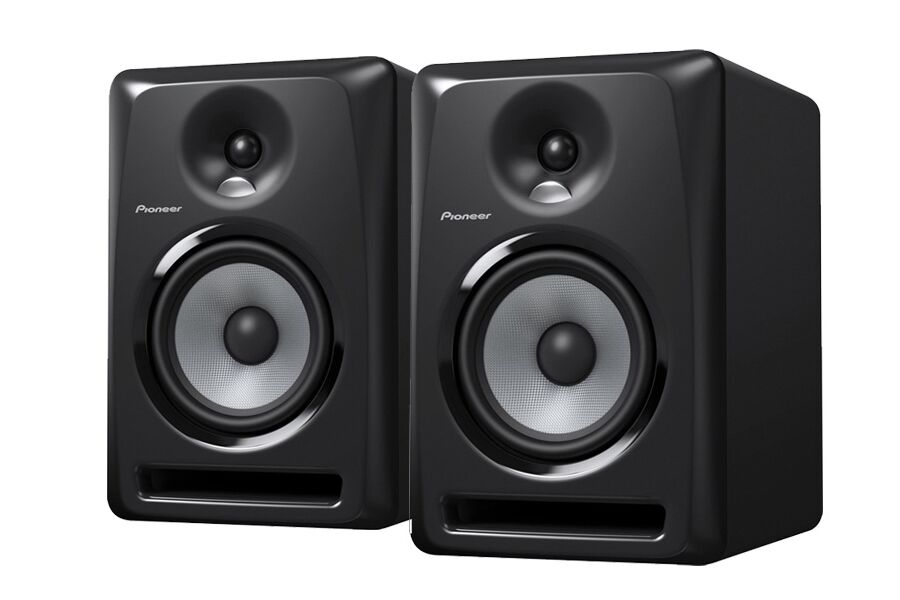The Lowdown
Similar in size and looks to the KRK Rokit 6 G3s, they also cost around the same – and sound very similar too. While purist producers will demand more, for most DJs, these are going to be more than enough, as they’re loud, have good bass and offer decent value for money.
Video Review
First Impressions / Setting up
The S-DJ60Xs, like their bigger and smaller cousins in the range, take their design cues totally from the KRK Rokit series. They’re the same overall size (a tiny bit bigger than the Rokit 6’s, but not much), the same shape (curved, especially at the front) and the same overall design (studio monitor style, bi-amped, independent active speakers, with front bass reflex ports). Superficially, they have white domes instead of KRK’s trademark yellow, but they’re aiming at the same market and have the same overall aesthetic.
As I say they’re sold separately and are individually powered, just like more expensive studio monitors, so each has a power socket, on/off switch and set of mono inputs around the back, in this case (as with the KRKs) balanced TRS, balanced XLR, and unbalanced RCA. So to set up you plug each in, and plug a lead from the left hand output of your controller or mixer to a suitable input on the left-hand speaker, and the same for the right.
They usefully (and again, also like the most recent KRK Rokit range) also have a large square foam pad attached on the bottom to save you messing around with a sheet of foam pads that you stick on yourself, as with some speakers at this price point, in order to isolate the bases from the surface they’re on.
In Use
As monitor speakers, these aren’t meant to be used to “colour” the sound in any way (indeed, the aim of monitors is supposedly to give you as true a possible an output so you can accurately mix), so don’t expect tone controls of any type: You do all that stuff on your mixer. So there is just a fine-tuning high frequency level adjust knob with four settings, with which you can tail off or very slightly boost the highs to suit the speaker positioning and your room. There’s no equivalent low frequency adjuster like the KRK Rokit range, though. I found it best slightly tailed off in our rather bright studio.
I’m not one for studying tech specs, but I can tell you that a pair of these is going to annoy the neighbours at well under their full capacity output. I found them to have excellent, deep bass, really punch mids (“thump” is a word that sprung to mid continually) and once I’d tweaked it, really pleasing high-end sound too. I compared them directly to the KRK Rokit 6s which are still in our studio from a recent review, and frankly it’s very hard to tell them apart – they’re both very good sounding speakers.
Conclusion
These speakers are designed for DJs to practice mixing on, and take their first steps in production with too. Once you’re spending thousands soundproofing your room, buying spiked stands, and losing sleep worrying about stereo imagery, all in the name of crafting original productions that will make you the next big dance producer, you’re going to want better speakers, and you’re going to need to spend appreciably more money on them.
Conversely, though, once you’re DJing at all seriously, you certainly don’t want to be using that old Logitech 2.1 gaming system, or worse, that $100 boxy “hi-fi” you nicked off your sister when she moved out as your primary DJing sound system. That’s where these, and similarly pitched models, come in.
The S-DJ60Xs lack a few of the bells and whistles of Pioneer’s more expensive DJ speakers (there’s no wired remote like on the S-DJ05s and S-DJ08s, for instance), but they do have a switchable “audio standby” to auto shut down when they have no signal going to them, which is neat.
Despite the marketing Pioneer did for them (hipsters dashing to cool parties, a pair of these under arm) you really shouldn’t use speakers like this at parties, trust me (exposed cones and wild parties = total no go, to start with). But for their true target audience – DJs who’ve outgrown their consumer speakers, but aren’t ready to drop a grand on reference studio monitors they don’t really need right now – these hit the spot, at exactly the same price point as the KRK Rokits.
And as they sound pretty much identical too, I hope you won’t criticise me for being too shallow when I say that once you’ve decided on the size (5s for smaller rooms, these for most, 8s for large spaces), the choice may well come down to which you prefer: Yellow or white cones? 🙂


